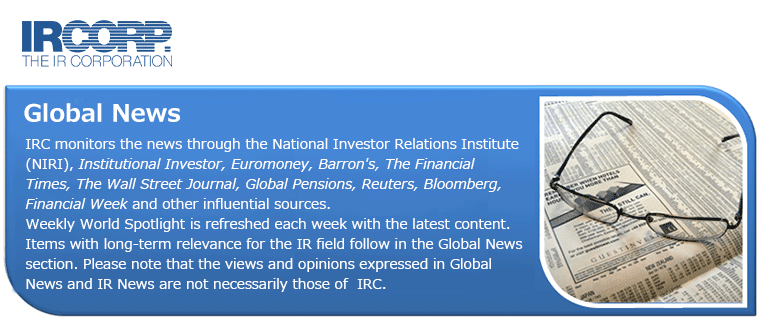Euromoney (October Issue)
“Rates will rise as the Fed begins tapering. “Short-term interest rates will rise to 3% over the next two to three years, with the 10-year and 30-year rate likely to reach the 6% range,” according to Mike Niedermeyer of Wells Fargo Asset Management. He adds, “I think people will be surprised by the relative performance of equities over fixed income. Past decisions have forced a correlation between fixed income and equities but we could now have a return to negative correlation between fixed income and equities.”
Tags: Correlation, Equities, Fed, Fixed income, Interest rates, Niedermeyer, Performance, Tapering, Wells Fargo
Wall Street Journal (October 30)
Al Gore warns a carbon asset bubble “is still growing because most market participants are mistakenly treating carbon risk as an uncertainty, and are thus failing to incorporate it in investment analyses. By overlooking a known material-risk factor, investors are exposing their portfolios to an externality that should be integrated into the capital allocation process.” If we are to avoid catastrophic levels of global warming, many fossil fuel reserves will ultimately end up as stranded carbon assets. “The transition to a low carbon future will revolutionize the global economy and present significant opportunities for superior investment returns. However, investors must also acknowledge that carbon risk is real and growing. Inaction is no longer prudent.”
Tags: Al Gore, Capital, Carbon assets, Carbon risk, Fossil fuel, Global economy, Global warming, Investment, Investors, Material-risk factor, Opportunities, Returns
Los Angeles Times (October 28)
“Policymakers are clear about their bond-buying goal, but the Street isn’t listening.” Current Federal Reserve Chairman Ben S. Bernanke stated publicly that quantitative easing would continue until unemployment falls to 6.5%. “If we generate 200,000 new jobs every month, tapering starts in November 2016. If we see an average of only 148,000 new jobs each month, we won’t ever see Fed tapering…. Tapering is still a long way off.”
Tags: Bernanke, Bond-buying, Fed, Jobs, Policymakers, Quantitative easing, Tapering, Unemployment, Wall Street
Institutional Investor (October Issue)
We are living in “disparate times.” Income inequality hit a record in 2012, with the top 10% accounting for 50.4% of total earnings. Much as hypertension can lead to a coronary event, “inequality my leave markets prone to crashes.”
Bloomberg (October 28)
“Foreign investors have boosted South Korean stock holdings for a record 41 straight days, lured by the nation’s current-account surplus, strengthening currency and fastest growth in almost two years.”
Washington Post (October 27)
“Not many countries would cheer about an economic growth rate of one-tenth of 1 percent, sustained for a mere three months. But for Spain, which has been mired in negative growth for two years, the tiny uptick in the third quarter of 2013 represents a kind of breakthrough.” For Europe, however, this is just the slightest hint of a “silver lining in a what is still a very dense, dark cloud hanging over Europe’s economy. Spain and its fellow euro-zone debtors — Italy, Portugal, Ireland and Greece — don’t just need a trickle of growth to bring down their unemployment rates and debt-to-gross-domestic-product ratios. They need a gusher; many consecutive months of high-single-digit growth. And there is no short-term prospect of that.”
Tags: Breakthrough, Debt, Economy, Euro zone, Europe, GDP, Greece, Growth, Ireland, Italy, Portugal, Spain, Unemployment, Uptick
The Economist (October 26)
“The euro mess has morphed from an acute crisis into a chronic one.” In contrast with the progress made on sovereign debt, however, “the euro zone has made less headway than other places in reducing this private-debt burden…. If the euro zone’s recovery is to strengthen, this burden of private debt must be lightened. According to the IMF, private debt is a bigger drag on Europe’s growth than government debt.”
Tags: Burden, Crisis, Euro zone, Europe, Government, Growth, IMF, Private-debt, Progress, Recovery, Sovereign debt
Financial Times (October 25)
“A painful and protracted hangover from the financial crisis has slashed demand for cars in Europe, forcing mainstream manufacturers to close factories, lay off workers and fill their financial statements with red ink.” Despite these measures, however, the industry is still struggling with overcapacity, compelling many global automakers to subsidize European losses with sales elsewhere. Providing a glimmer of optimism for Europe, however, Ford “called the bottom of the disastrous market slump on Thursday, the first carmaker confident enough to turn tentative hopes into official profit guidance and draw a financial line under six years of falling sales.”
Tags: Automakers, Carmakers, Demand, Europe, Factories, Financial Crisis, Ford, Guidance, Losses, Manufacturers, Optimism, Overcapacity, Sales, Workers
Wall Street Journal (October 24)
“After earning big profits at home, Chinese investors are looking abroad for safer assets that offer steady returns. They are shifting their increasingly valuable currency out of China’s expensive property market and into the likes of Manhattan and San Francisco—bargains by comparison.”
Tags: Bargains, China, Investors, Manhattan, Profits, Property markets, Safe assets, San Francisco, Steady returns. Currency
Euromoney (October Issue)
Warning some stock exchanges could face downgrades, ratings agency S&P cautioned that they “have become more prone to operational risk.” Fragmentation is one key challenge. “There are now 16 SEC-registered securities exchanges in the US and more than 50 alternative trading systems, whereas before 2005 the equities market was dominated by NYSE and Nasdaq. It is this interconnectivity that is fueling operational risk. When Nasdaq halted trading in August, for example, other stock exchanges, including NYSE, Bats and Direct Edge, were also forced to stop trading in Nasdaq-listed securities.”
Tags: BATS, Challenge, Direct Edge, Downgrades, Fragmentation, Interconnectivity, Nasdaq, NYSE, Operational risk, S&P, SEC, Securities, Stock exchanges, Trading, U.S.


